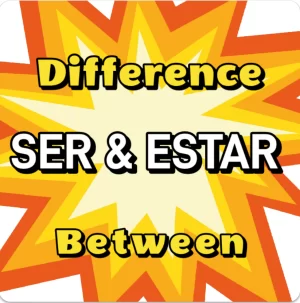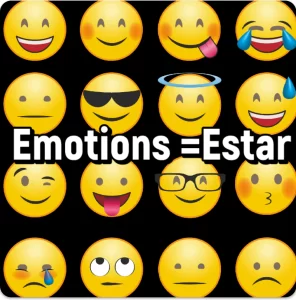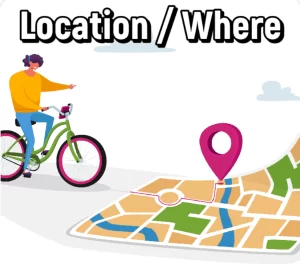
Estar Verb Conjugations
Examples of Ser with Places or Things:
- Los tacos son deliciosos.
- Atlanta es una ciudad grande.
- El restaurante es bueno.
- Miami es una ciudad bella.
- El parque Piedmont es popular.
These examples use Ser in Spanish because we are either describing/ providing more info and details about a subject. This is the nature of Ser! Need to practice Ser? Get our affordable Ser verb conjugations worksheets!
When do you use Estar?
- Talking about WHERE a subject is ( not who they are)
- Talking about a subject’s emotional state!
- Talking about the condition of a subject.

Estar is a more hard working verb because it handles 3 things! Ser really just does one job- very well but still 1 🙂
Estar verb conjugations:
Yo estoy
Tù estàs
Èl/ella/usted està
Nosotros estamos
Ellos/ ellas/ ustedes estàn
How to use Estar in Spanish?
- Yo estoy en la casa.
- La escuela està en Atlanta.
- Ellas estan en el parque Piedmont.
- Mi familia està en Italia.
- La doctora està en el hospital.
- Yo estoy triste.
- Melinda està enferma
- El coche està sucio.

Most of these examples are about location! The WHERE of the subject. This is how you use Estar! Example #6 is about the person’s emotional state! It talks about the person’s feelings. Example #7 talks about the subject’s condition= being unwell! & #8 talks about the condition of the car!
Estar can be more complicated. Focus on the where; the location aspect of this verb. Get comfortable with that first, then work on emotions & conditions. Spanish in Atlanta offers affordable practice worksheets for Ser verb conjugations & Estar verb conjugations are coming soon!. Written work is key for retention and mastery!
Estar Verb Conjugations & Ser Verb Practice Video!
Rare Exceptions of Ser & Estar
It’s rare but there are times when you can use BOTH Ser and Estar!

LOL don’t worry! First make sure that you work on the normal functions of Ser and Estar! Afterwards, you can work on the exceptions. Below are some examples of how a sentence and it’s message can change drastically by just changing the Ser or Estar verb. Check out our main blog page for more free Spanish language lessons & posts!
Examples of Ser & Estar Exceptions:
- Ella està enferma.
- Ella es enferma.
- Ellos son felices
- Ellos estàn felices
- Èl es loco.
- Èl està loco.
Ella està enferma just means that this person´s (the subject) health condition is bad! This person is sick; has an illness etc… VS Ella es enferma which speaks about the person being sick- a sick person! When you use SER you are treating enferma like an adjective instead of a condition. That is why Estar is the best choice!
Ellos son felices refers to the personality. Felices is being used to describe the person versus their emotional state so saying Ellos estàn felices only focuses on the subject´s emotions- feelings not their personality type.
Èl es loco would mean this person is mad loco! lol Should be locked up or given medications versus Èl està loco which means this person is acting that way- you are sharing your observation about ¨where¨they are emotionally etc… and not their personality.
How to practice Ser & Estar ?
- Practice introducing yourself in Spanish & others.
- Talk about your location- where you are everyday.
- Print our conjugations chart for Estar
- Do written work & practice conjugating Ser & Estar.
- Take a family group foto & introduce everyone.
- Purchase our affordable Ser conjugations worksheets!
- Look at people & describe their emotional state.
Spanish in Atlanta creates a lot of free Spanish practice content & affordable practice worksheets. If you would like to see us include free mini quizzes, comment below!

Want to learn Spanish with Us?
Take one of our 6 week Spanish courses LIVE via zoom. We offer a free mini demo, assessment & placement! Talk to our professional Spanish instructor and get the answers you need before signing up! We have small group courses, private instruction & unlimited Spanish lessons. Need just a few tutoring sessions to go over anything you are struggling with? Contact Spanish in Atlanta and get professional 1 on 1 help!






13 Comments
Estar verb and Ser have always been tough. I think I understand the difference but when I speak spanish I feel like I make so many mistakes. This was helpful. Do you offer Spansih tutoring like if I want to do 1 or 2 private lessons? I am studying Spanish on my own but I get stuck sometimes. I would like to pay for help for those times. Is this possible?
Hola Rigoberto, yes Spanish in atlanta offers a la carte tutoring sessions too! We offer Spanish courses but if you just need 1 or 2 hours to ask all the questions you want and go over things that are confusing, you can do that.
Just contact us and we can create the sessions for you. We typically offer Spanish tutoring packages on our website so you wont see that option on our website.
I love all your videos & content. I have gotten better. I will consider taking a Spanish class in the future. Do you do a placement test? Thanx
Yes, you can schedule for free on our website- just click on free demo and from there just schedule it. We will contact you over the phone or via zoom to do your free Spanish placement test, assessment or just professional guidance.
Sometimes I’m not sure which one fits best. For example, if I want to say “I am happy,” should I use soy or estoy? I know both could make sense, depending on the situation, but I’m never fully confident I’m using the right one. Can ser and estar both be used in certain sentences, or is it always one or the other? It feels like it depends a lot on context, and that makes it difficult to get right every time.
Are there any tips or tricks to help decide quickly which verb to use when speaking or writing? I’d love to feel more comfortable with these two verbs since they’re used so often in everyday Spanish.
Thanks! I love learning Spanish, but ser and estar always trip me up!
Yes, most of the time you are going to use just SER or ESTAR but there are exceptions where you can technically use both verbs. Best “tip” is what I mentioned in the blog post. Ser is for who you are and estar is for where. Read the blog above and once you are good, I recommend going over the exceptions. Be patient! I promise it gets better 🙂
The sentence “Yo soy de Chicago.” I’m a bit confused why the verb ser is used here instead of estar, since Chicago is a location. I thought estar was used for locations, so shouldn’t it be “Yo estoy de Chicago”? Could someone explain why ser is correct in this sentence and how to know when to use it for locations? I’m still figuring out the differences between ser and estar but this post has helped me a lot!
I’ve heard both “yo soy casado” and “yo estoy casado” used in Spanish, and I’m confused. Can you actually use both, or is one of them wrong? I thought ser was for permanent things and estar for temporary states, but marriage seems like something permanent. Does this mean “soy” is more correct, or is there a reason why estar can also be used? I’d love to understand the difference and when to use each one, or if it’s just a common mistake people make. Any help clearing this up would be great! Thanks!
Hola Maddie, most of the time it’s going to be either Ser or Estar not both but there are exceptions and your sentence is an example of when you can use both.
Yo soy casado= means you identify as a person that is casado versus
Yo estoy casado= means it is your marital status
You are saying the same thing for the most part but its a different perspective of it.
I always mix up *ser* and *estar,* and it’s funny but also kind of frustrating! I’ll use *ser* when I’m supposed to use *estar,* and people look at me like, What are you saying? It’s one of those things that keeps tripping me up, but I guess it’s part of learning the Spanish language! I am curious. Is this a Spanish language thing or do other langauges share these rules?!?!
I really enjoy reading the Spanish in Atlanta blog—it’s been super helpful for learning all these tricky grammar rules. Do you have any practice worksheets that focus specifically on *ser* vs *estar*? I feel like more exercises would definitely help. Thanks for all the great content!
After reading the Spanish in Atlanta post about ser and estar, I feel a lot more confident with these tricky verbs! The explanations really cleared things up for me. Are there other verbs in Spanish that work like this, where the meaning changes depending on the context? I’d love to know if there are more verbs I should look out for. Thanks for the helpful post and any other advice you can share!
I was wondering if it’s possible to say “yo estoy su amiga” instead of “yo soy su amiga.” I know *ser* is for more permanent things, like relationships, and *estar* is for temporary states. But could you use *estar* in this case, or would that be incorrect?
It makes me think about how temporary vs. permanent applies in Spanish, and if it would change the meaning of a sentence like this. Should I worry if someone says yo estoy su amigo – does that mean that are friendship is temporary?? :0 LOL I’d love to understand this better because it’s still confusing for me. Thanks for the help
Hola Lauren, jajaja no don’t worry! Even if you don’t foresee a friendship being forever that doesn’t mean that you will use the Estar verb 🙂 So it’s impossible to say
Yo estoy su amiga= amiga is not a location and not an emotion so that is the main reason why you can use that verb.
Temporary and permanent rules are not good- they lead to more confusing in my experience so I suggest you think more of WHO vs WHERE